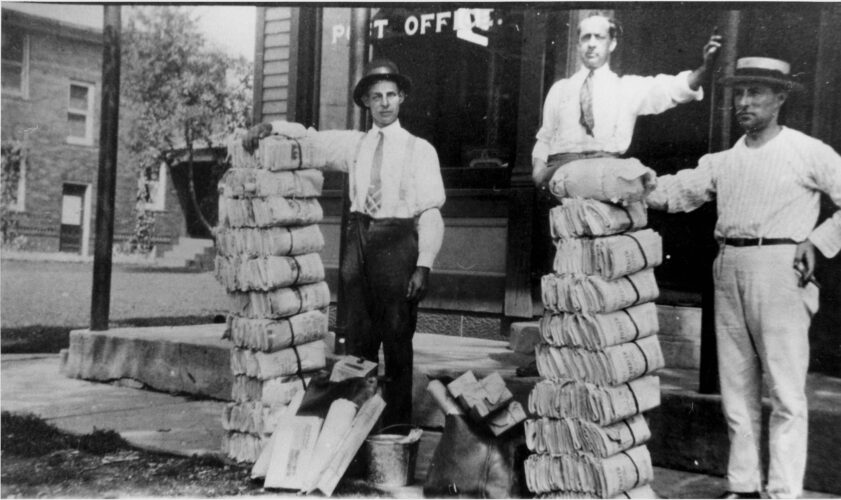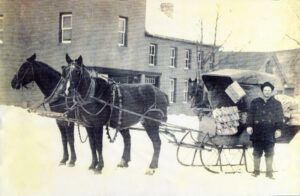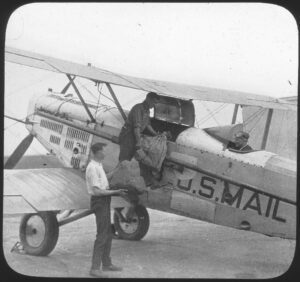From Horses to Missiles: The transportation of the U.S. Postal Service

The first national postal agency in the US, known as the United States Post Office (USPS) was founded by the Second Continental Congress in Philadelphia on July 26, 1775, at the beginning of the American Revolution. Benjamin Franklin was appointed the first postmaster general as he had already served in a similar role overseeing Britain’s colonial mail service. From 1753 to 1774, Franklin improved the courier system connecting the 13 fragmented colonies into a more efficient organization that sped deliveries between Philadelphia and New York City to a mere 33 hours.
As the United States grew and expanded its territory, the mode of transportation and delivery had to adapt and grow as well. William H. Russell advertised for riders to work on the Overland Express Route via Salt Lake City in March 1860. Russell’s plan was for an express route to carry mail between St. Joseph, Missouri, the westernmost point reached by the railroad and telegraph, and California, but many thought that year-round transportation across this area was impossible because of extreme weather conditions. With partners Alexander Majors and William B. Waddell, Russell formed the Central Overland California and Pike’s Peak Express Company. They built new relay stations and prepared existing ones. Riders were recruited hastily but, before being hired, had to swear on a Bible not to cuss, fight, or abuse their animals and to conduct themselves honestly. On April 3, 1860, the Pony Express began its run through parts of Missouri, Kansas, Nebraska, Colorado, Wyoming, Utah, Nevada, and California. The first mail by Pony Express from St. Joseph to Sacramento took ten days, cutting the overland stage time via the southern route by more than half. On July 1, 1861, the Pony Express began operating under contract as a mail route, but officially ended October 26, 1861, after the transcontinental telegraph line was completed.

Horses, trains, planes and even steamboats have been known forms of transportation for the mail, yet there are a few lesser-known modes of travel that may surprise you. From 1899 to the early 1910s, reindeer helped transport mail to more than a dozen Post Offices in northwestern Alaska, including several located north of the Arctic Circle. Unlike caribou, which were native to Alaska, semi-domesticated reindeer were imported to Alaska in the 1890s from Siberia and northern Scandinavia along with reindeer herders to teach the native Alaskans how to handle, care for, and train the deer. It’s unclear when reindeer were last used to carry mail in Alaska. When postal inspectors Walter Cookson and Frank Smith investigated postal conditions in Alaska in 1912, they found that reindeer were used by “Esquimo carriers” in the “extreme north,” presumably on the Barrow–Kotzebue mail route. But a 1917 article in The Postmasters’ Advocate noted that dogsleds were used on this route, and in June 1923, postal inspectors reported that 23 dogsled routes and 3 horse sled routes served the whole of Alaska the previous winter; no reindeer routes were mentioned. Today, mail is transported to the Barrow Post Office by airplanes, which replaced dogsleds on the northernmost mail route in the 1940s.

Throughout its history, the Postal Service has explored faster, more efficient forms of mail transportation. One remains only a footnote in the history of mail delivery – missile mail. On June 8, 1959, in a move that Postmaster General Arthur A. Summerfield heralded as “of historic significance to the peoples of the entire world,” the Navy submarine USS Barbero fired a guided missile carrying 3,000 letters towards the naval auxiliary air station in Mayport, Florida. Racing along at about 600 miles per hour, the guided missile traveled more than 100 miles from the deck of the submarine off the coast of Florida to the air station in about 22 minutes. The letters, in special commemorative envelopes, were all from the Postmaster General to leading government officials and prominent citizens with a special interest in the Post Office Department.
No matter how far technology advances, there will still be a need for the Postal Service to carry mail across the country and around the world. What mode of transportation will be next is something only the future can show us. For now, let’s remember what came before and make it better. Find more information and photos from the history of the United States Postal Service on Ohio Memory!
Thank you to Ashely Rodriguez, Digital Projects Coordinator at the Ohio History Connection, for this week’s post!



Leave a Reply
You must be logged in to post a comment.